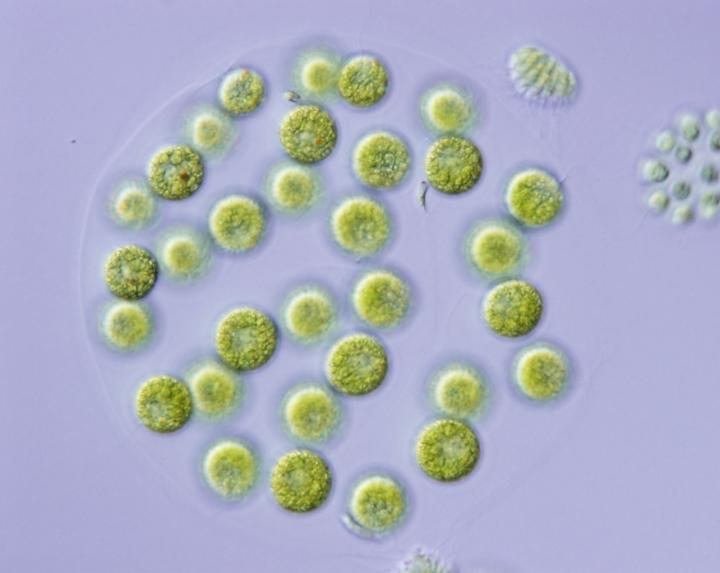Studies in green algae have generated some surprising new findings on the genetic changes that might have underpinned the evolution of male and female gametes. While prior studies in both animals and plants suggest that large-scale genetic expansion and differentiation must have occurred to enable the divergence of male and female chromosomes, new research in two closely related multicellular green algae suggests that the genetic differences may, in fact, have been far less dramatic.
“This new study punches a hole in the idea that increased genetic complexity of sex chromosomes accompanied the origin of sexes,” says James Umen, Ph.D., at the Donald Danforth Plant Science Center in St. Louis. The researchers, led by Hisayoshi Nozaki, Ph.D, at the University of Tokyo in Japan, report their findings in Communications Biology. Their paper is entitled “Anisogamy Evolved with a Reduced Sex-Determining Region in Volvocine Green Algae.”
Unicellular organisms commonly produce morphologically identical gametes, known as isogametes. In contrast, male–female gamete dimorphism is a key characteristic of most multicellular organisms, including plants, animals, and fungi, the authors write.
Organisms in which the male and female gametes do differ in size—which is known as anisogamy—have evolved from ancestors bearing similar sized gametes—isogamy—and this divergence has happened independently along a number of eukaryotic evolutionary roads. In most lineages, however, anisogamy evolved so very long ago that there aren’t any close isogamous relatives still existing, which makes it hard to look at the genetic steps that might have allowed the switch from isogamy to anisogamy and oogamy, the form of anisogamy in which there is a small motile male gamete and a large, nonmotile female gamete, or egg cell.
Dr. Hisayoshi Nozaki’s team has been investigating the evolution of male and female sexes in freshwater photosynthetic multicellular algae known as volvocine green algae. “…sex-determining genes and sex chromosomal regions or mating-type loci (MT) have been studied extensively in both isogamous and sexually dimorphic volvocine green algae,” they explain.
For the latest studies the team focused on two closely-related 32-cell volvocine green algae, Yamagishiella unicocca and Eudorina sp. While both organisms share the same asexual morphology, Yamagishiella is isogamous, whereas Eudorina is anisogamous. The team sequenced each organism’s nuclear DNA to identify the MT locus in the Yamagishiella and Eudorina species and compare the regions with each other, and with that of Volvox, another more advanced 500-cell volvocine organism that exhibits oogamy.
Evolutionary theory would predict that the transition from isogamy to anisogamy would be accompanied by expansion and increasing complexity of the sex-determining region in Eudorina, when compared with Yamagishiella. However, the results suggested that the opposite was actually true. Eudorina had the smallest and least genetically complex sex-determining region found among any of the volvocine species identified to date. In addition, there appeared to be only two sex-limited genes separating isogamy and anisogamy, the minus/male-limited sex-determining factor, MID gene, and the plus/female-limited gamete recognition factor gene, FUS1, which is also found in isogamous Yamagishiella.
Essentially, differentiation between male and female gametes in Eudorina was determined by presence of the male MID gene The tiny, sex-determining regions in both Eudorina and the Yamagishiella species (in which the MT region was up to 268 kb) compared with the much more complex Volvox MT, which was greater than 1 Mb in size.
“Contrary to expectations for increased MT size and gene content evolving during the transition to anisogamy, the Eudorina sp. male and female MT haplotypes are very small, 7 kb and 90 kb in size, respectively, with only two sex-specific genes,” the authors write. “Thus, the first step to anisogamy in volvocine algae presumably occurred without an increase in MT size and complexity….Therefore, in this lineage the transition to anisogamy likely involved direct modification of the sex determination pathway controlled by MID rather than by acquisition of new gamete size control genes in MT.”
The researchers suggest their findings could also have implications for the development of industrial species of algae. “…the work also has practical implications since it expands our understanding of how to identify mating types and sexes in new species of algae that we might want to breed as crops for improved traits relating to biofuel or biotechnology applications,” Dr. Umen comments.



